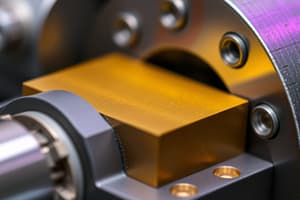Podcast
Questions and Answers
What is the primary material property needed for the teeth of a digger truck?
What is the primary material property needed for the teeth of a digger truck?
- Lightweight structure
- High hardness (correct)
- Resistance to oxidation
- Thermal expansion
Which property is crucial for the teeth of a digger truck to avoid snapping during operation?
Which property is crucial for the teeth of a digger truck to avoid snapping during operation?
- High fracture toughness (correct)
- Low density
- Low cost
- High thermal conductivity
What is the maximum service temperature for stainless steel?
What is the maximum service temperature for stainless steel?
- 600 °C
- 150 °C
- 500 °C
- 800 °C (correct)
What issue can arise from thermal expansion if a material, like a rod, is constrained?
What issue can arise from thermal expansion if a material, like a rod, is constrained?
Why is the cost of materials not a primary concern for the teeth of a digger truck?
Why is the cost of materials not a primary concern for the teeth of a digger truck?
What characterizes materials that are considered brittle?
What characterizes materials that are considered brittle?
What property is used to measure a material's resistance to cracking and fracture?
What property is used to measure a material's resistance to cracking and fracture?
Most steels have which of the following properties?
Most steels have which of the following properties?
Which material is exemplified as having very low fracture toughness?
Which material is exemplified as having very low fracture toughness?
What happens to a glass ruler when subjected to bending?
What happens to a glass ruler when subjected to bending?
Why is minimizing weight crucial in vehicle design?
Why is minimizing weight crucial in vehicle design?
How does the density of aluminum compare to that of lead?
How does the density of aluminum compare to that of lead?
What would be the consequence of making an aircraft out of lead?
What would be the consequence of making an aircraft out of lead?
What is one of the primary considerations in selecting materials for engineering projects?
What is one of the primary considerations in selecting materials for engineering projects?
Why is compatibility between materials and processes important in engineering?
Why is compatibility between materials and processes important in engineering?
Which of the following statements reflects a potential consequence of material failure?
Which of the following statements reflects a potential consequence of material failure?
What does the term 'design-limiting properties' refer to?
What does the term 'design-limiting properties' refer to?
Which historic figure is mentioned in relation to engineering and materials?
Which historic figure is mentioned in relation to engineering and materials?
What is a primary goal when choosing materials and processes in engineering?
What is a primary goal when choosing materials and processes in engineering?
Which of the following is NOT typically a consideration for materials used in engineering?
Which of the following is NOT typically a consideration for materials used in engineering?
What role do processes play in material selection according to the provided content?
What role do processes play in material selection according to the provided content?
What was the primary challenge faced by engineers in the era of pre-historic materials?
What was the primary challenge faced by engineers in the era of pre-historic materials?
Which of the following materials is NOT mentioned as a natural material from pre-history?
Which of the following materials is NOT mentioned as a natural material from pre-history?
What does the development of thermo-chemistry and polymer chemistry primarily enable?
What does the development of thermo-chemistry and polymer chemistry primarily enable?
Why is making the right choice of material increasingly important today?
Why is making the right choice of material increasingly important today?
What is a significant change in engineering practice since Professor Stuart's day?
What is a significant change in engineering practice since Professor Stuart's day?
Which tool is considered standard in an engineer's training today?
Which tool is considered standard in an engineer's training today?
What role does the ASM Materials Handbook play in material selection?
What role does the ASM Materials Handbook play in material selection?
How has software influenced the selection of materials and processes?
How has software influenced the selection of materials and processes?
What property distinguishes 'hard' magnetic materials from 'soft' magnetic materials?
What property distinguishes 'hard' magnetic materials from 'soft' magnetic materials?
Which of the following best describes materials with high dielectric constants?
Which of the following best describes materials with high dielectric constants?
What is the primary characteristic of 'soft' magnetic materials?
What is the primary characteristic of 'soft' magnetic materials?
What is remanence in the context of magnetism?
What is remanence in the context of magnetism?
How do electric currents and magnetic fields interact?
How do electric currents and magnetic fields interact?
Which type of materials are characterized as having low resistivity?
Which type of materials are characterized as having low resistivity?
In which application are 'hard' magnetic materials typically NOT used?
In which application are 'hard' magnetic materials typically NOT used?
What is the role of dielectric properties in materials?
What is the role of dielectric properties in materials?
What is the key property that measures how large a field a material can conduct?
What is the key property that measures how large a field a material can conduct?
Which material property is essential for eyeglass lenses to ensure functionality?
Which material property is essential for eyeglass lenses to ensure functionality?
What is a desirable property of materials for spectacle lenses related to their physical characteristics?
What is a desirable property of materials for spectacle lenses related to their physical characteristics?
Which of the following environments is specifically mentioned as corrosive to materials?
Which of the following environments is specifically mentioned as corrosive to materials?
What allows products to survive in hostile environments according to the content?
What allows products to survive in hostile environments according to the content?
Which factor contributes to the desirability of eyeglass lens materials from a manufacturing standpoint?
Which factor contributes to the desirability of eyeglass lens materials from a manufacturing standpoint?
What common property of materials allows them to interact with light?
What common property of materials allows them to interact with light?
In terms of product design, what is mentioned as a requirement for materials exposed to aggressive environments?
In terms of product design, what is mentioned as a requirement for materials exposed to aggressive environments?
Flashcards
Materials
Materials
A substance used to create things. Engineers need to consider how materials respond to various conditions, such as heat, electricity, and external forces, and ensure their choices are environmentally responsible.
Processes
Processes
The methods and techniques used to shape, join, and refine materials. Processes must be compatible with the materials used to avoid failure.
Strength (mechanical property)
Strength (mechanical property)
The ability of a material to withstand forces, such as pressure, tension, or shear. This is a crucial factor in choosing the right materials for different applications, like bridges or building structures.
Thermal Conductivity (thermal property)
Thermal Conductivity (thermal property)
Signup and view all the flashcards
High-temperature resistance (thermal property)
High-temperature resistance (thermal property)
Signup and view all the flashcards
Compatibility
Compatibility
Signup and view all the flashcards
Material failure
Material failure
Signup and view all the flashcards
Historical perspective in material selection
Historical perspective in material selection
Signup and view all the flashcards
Man-made materials
Man-made materials
Signup and view all the flashcards
Technological Era
Technological Era
Signup and view all the flashcards
Material Selection
Material Selection
Signup and view all the flashcards
Materials Database
Materials Database
Signup and view all the flashcards
Computer-Aided Design (CAD)
Computer-Aided Design (CAD)
Signup and view all the flashcards
Finite Element Analysis (FEA)
Finite Element Analysis (FEA)
Signup and view all the flashcards
Optimization
Optimization
Signup and view all the flashcards
Hybrid Materials
Hybrid Materials
Signup and view all the flashcards
Yield strength
Yield strength
Signup and view all the flashcards
Stiffness
Stiffness
Signup and view all the flashcards
Fracture Toughness
Fracture Toughness
Signup and view all the flashcards
Brittle Material
Brittle Material
Signup and view all the flashcards
Tough Material
Tough Material
Signup and view all the flashcards
Density
Density
Signup and view all the flashcards
Tensile Strength
Tensile Strength
Signup and view all the flashcards
Ductile Materials
Ductile Materials
Signup and view all the flashcards
Temperature Sensitivity
Temperature Sensitivity
Signup and view all the flashcards
Maximum Service Temperature
Maximum Service Temperature
Signup and view all the flashcards
Creep
Creep
Signup and view all the flashcards
Thermal Expansion Coefficient
Thermal Expansion Coefficient
Signup and view all the flashcards
Dielectric Response
Dielectric Response
Signup and view all the flashcards
Microwave Transparency
Microwave Transparency
Signup and view all the flashcards
Microwave Reflectivity
Microwave Reflectivity
Signup and view all the flashcards
Electromagnetism
Electromagnetism
Signup and view all the flashcards
Hard Magnetic Materials
Hard Magnetic Materials
Signup and view all the flashcards
Remanence
Remanence
Signup and view all the flashcards
Soft Magnetic Materials
Soft Magnetic Materials
Signup and view all the flashcards
Magnetic Conductivity
Magnetic Conductivity
Signup and view all the flashcards
Saturation Magnetization
Saturation Magnetization
Signup and view all the flashcards
Transparent Materials
Transparent Materials
Signup and view all the flashcards
Opaque Materials
Opaque Materials
Signup and view all the flashcards
Refractive Materials
Refractive Materials
Signup and view all the flashcards
Chemical Resistance
Chemical Resistance
Signup and view all the flashcards
High-Temperature Resistance
High-Temperature Resistance
Signup and view all the flashcards
Thermal Conductivity
Thermal Conductivity
Signup and view all the flashcards
Study Notes
Materials, Processes, and Choice
- Engineers create objects from materials using processes
- Materials need to withstand loads, insulate/conduct heat/electricity, resist magnetic/light flux, and be environmentally friendly/affordable
- Compatibility between material and process is crucial
- Process can be dominant, forcing material selection, creating marriages.
Material Properties
-
Mechanical:
- Stiffness (elastic modulus): Resistance to bending. High E values (e.g., steel) equate to stiffness. Low E values (e.g., polyethylene) are less stiff.
- Strength (yield strength): Resistance to permanent deformation. High σy (e.g., titanium alloys) are harder to deform.
- Toughness (fracture toughness): Resistance to cracking. High K₁c (e.g., steel) value indicates toughness. Low K₁c (e.g., glass) indicates brittleness.
- Density (p): Mass per unit volume. High density (e.g., lead) is undesirable in many applications (e.g., aircraft).
-
Thermal:
- Maximum service temperature (Tmax): The highest temperature a material can withstand without significant degradation. High Tmax is favorable (e.g., stainless steel).
- Thermal expansion coefficient (a): How much a material expands or contracts with temperature. High a can cause problems in constrained systems (e.g., railroad track).
-
Electrical/Magnetic/Optical:
- Electrical conductivity (λ): How well a material conducts heat. High λ is desirable for heat transfer; low λ insulates effectively.
- Heat capacity (Cp): Amount of heat required to raise a material's temperature. High Cp (e.g., copper) takes more heat to change temperature.
- Resistivity (ρe): Resistance to electrical current. High ρe is good for insulators, low ρe is good for conductors.
- Dielectric constant (ε): Response to electrical fields. Low values don't respond to fields. High values respond to electric fields and reorientate molecules.
- Magnetic properties:
- Remanence: The intensity of retained magnetism
- Soft/hard magnetism: Materials easy/difficult to magnetize and demagnetize
- Optical properties:
- Transparency/opaqueness, absorption, refraction: How light interacts with a material (e.g., eye glasses).
-
Chemical: -Resistance to various environments (acids, alkalis, water, etc.). -Corrosion resistance -Chemical inertness
Design-Limiting Properties
- Properties that restrict the performance of a component or item.
- Values need to meet certain targets to meet performance requirements.
Summary and Conclusions
- Design relies on materials properties
- Design-limiting properties must meet specified targets
- Processes also have properties influencing design
Studying That Suits You
Use AI to generate personalized quizzes and flashcards to suit your learning preferences.




